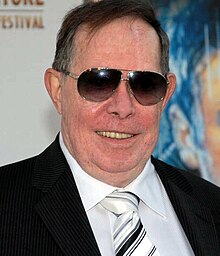|
Syd Mead
Sydney Jay Mead (July 18, 1933 – December 30, 2019)[3] was an American industrial designer and neo-futurist concept artist. He made designs for science-fiction films such as Blade Runner, Aliens and Tron. Mead has been described as "the artist who illustrates the future" and "one of the most influential concept artists and industrial designers of our time."[4][5] LifeEarly lifeMead was born on July 18, 1933, in Saint Paul, Minnesota. His father was a Baptist minister, who read him pulp magazines, such as Buck Rogers and Flash Gordon, sparking his interest in science fiction. Mead was skilled in drawing at a young age. According to Mead, "by the time I was in high school I could draw the human figure, I could draw animals, and I had a sense of shading to show shape. I was really quite accomplished at that point with brush technique and so-forth." He described himself as being an "insular child."[4] Mead graduated from high school in Colorado Springs, Colorado, in 1951. After serving a three-year enlistment in the U.S. Army, Mead attended the Art Center School in Los Angeles (now the Art Center College of Design, Pasadena), where he graduated in June 1959.[6] Career In 1959, Mead was recruited to Ford Motor Company's Advanced Styling Studio by Elwood Engel. From 1960 to 1961, Mead worked in Ford Motor Company Styling in Detroit, Michigan. Mead left Ford after two years to illustrate books and catalogues for companies including United States Steel, Celanese, Allis-Chalmers and Atlas Cement. In 1970, he launched Syd Mead, Inc. in Detroit with clients including Philips Electronics.[6] With his own company in the 1970s, Mead spent about a third of his time in Europe, primarily to provide designs and illustrations for Philips, and he continued to work for international clients.[7] Through the 1970s and 1980s, Mead and his company provided architectural renderings, both interior and exterior, for clients including Intercontinental Hotels,[8] 3D International, Harwood Taylor & Associates, Don Ghia, Gresham & Smith[9] and Philip Koether Architects.[10] Beginning in 1983, Mead developed working relationships with Sony, Minolta, Dentsu, Dyflex, Tiger Corporation, Seibu, Mitsukoshi, Bandai, NHK and Honda.[11] Mead's one-man shows began in 1973 with an exhibit at documenta 6 in Kassel, West Germany. His work was later exhibited in Japan, Italy, California and Spain.[11] In 1983, Mead was invited by Chrysler Corporation to be a guest speaker to its design staff. He created a series of slides to provide visuals to the lecture, and the resulting presentation was a success. It was later expanded and enhanced with computer-generated images specifically created at the requests of several clients, including Disney, Carnegie Mellon University, Purdue University, Pratt Institute and the Society of Illustrators. In March 2010, Mead completed a four-city tour of Australia.[7] In 1992, he participated in the production of a TurboGrafx-CD video game, Syd Mead's TerraForming.[12] [13] In 1993, a digital gallery consisting of 50 examples of his art with interface screens designed by him became one of the first CD-ROMs released in Japan. In 2004, Mead co-operated with Gnomon School of Visual Effects to produce a four-volume "how-to" DVD series titled Techniques of Syd Mead.[7] In 2018, Mead published his autobiography, titled A Future Remembered.[14] Regarding his work, Mead said, "the idea supersedes technique,"[7] and that "I've called science fiction 'reality ahead of schedule.'"[15] In filmMead is best known for his work on films such as Blade Runner. Some of Mead's concept art is visible in the background of the second image. Mead worked with major studios on the feature films: Star Trek: The Motion Picture, Blade Runner, Tron, 2010, Short Circuit, Aliens, Timecop, Johnny Mnemonic, Mission: Impossible III, Elysium, Tomorrowland and Blade Runner 2049.[3][16] George Lucas created the AT-AT for his Star Wars saga based on art by Mead.[17] Mead also contributed to the Japanese film Solar Crisis. In the 1990s, Mead supplied designs for two Japanese anime series, Turn A Gundam and the unfinished Yamato 2520.[16] In May 2007, he completed work on a documentary of his career with the director Joaquin Montalvan entitled Visual Futurist:The Art & Life of Syd Mead. The short 2008 documentary film 2019: A Future Imagined, also explored his works. Mead also appears in movie documentaries such as Dangerous Days: Making Blade Runner and Mark Kermode's On the Edge of Blade Runner, and promotional materials such as the DVD extra for Aliens and a promotional short film about the making of 2010.[18] Personal lifeMead was in a relationship with Roger Servick; the couple married in 2016.[19] They established a publishing extension, OBLAGON, Inc., in Hollywood[20] and relocated in 1998 to Pasadena, California, where Mead continued to work.[21] DeathOn December 30, 2019, Mead died in his Pasadena home at age 86, after three years of lymphoma.[6][22] Gallery of works
See alsoReferences
External linksWikiquote has quotations related to Syd Mead. Wikimedia Commons has media related to Syd Mead.
Interviews
|
||||||||||||||||||||








